Let’s cover a tricky topic: determining the right strategy for your next painting.
Your strategy is the general plan or approach for how you will end up with a painting that’s faithful to the subject and conveys your ideas. It broadly covers questions like… What medium will you use? What brushes? What colors? What style? In what order will you paint the parts? What speed will you paint? How many sessions will you need? What techniques will you use? And so on.
I never used to give strategy much thought. I would rush into a painting as soon as inspiration struck. But too often, this would lead to a confused mess on the canvas.
The right strategy can make the painting process much smoother and the chance of success much greater. It’s worth some attention!
This post will cover:
- What’s the End Goal?
- What’s the Easiest Way to Get There?
- Be Willing to Deviate From the Strategy
- “One Size Fits All” Strategies
- You Are the Best Person to Decide on the Optimal Strategy
- Practical Example
- Want to Learn More?
- Thanks for Reading!
What’s the End Goal?
You should first try to visualize the finished painting before you pick up a brush. You need an end goal in mind to come up with an appropriate strategy for how you’re going to get there.
If you cannot visualize a finished painting, perhaps that subject isn’t worth painting!
You should also consider what you want your painting to say. That is, what ideas about the subject do you want to communicate through your painting? Perhaps there’s an aspect of the subject that you want to really push and exaggerate. Or perhaps you want to convey the subject in a certain light or mood or style. Try to remember your first impressions of the subject. Those impressions are gold and usually contain hints as to what you really want to say about the subject. I’ll give you an example using my recent painting, Perth, Cape Peron. Below is the reference photo I painted from. When I took this photo, the wind was strong and crisp, and the sunlight was blinding. The shadows also had more of a blue tint than the photo shows. These are ideas and experiences that I tried to convey through my painting, and they are what make the painting unique and personal.


What’s the Easiest Way to Get There?
Once you have an end goal in mind, you should determine the easiest and most efficient way to get there. What’s the path of least resistance? Take that path. You don’t get any awards for doing things the hard and inefficient way.
Here are a few key areas to consider:
- Medium: Each medium has pros and cons, making them more or less suitable for certain situations. For example, if part of your end goal is to have a painting with luscious color and visible brushwork, then oil is your best bet. Watercolors, acrylics, or gouache just won’t get you there. Or say you want to convey the subject in a soft, ethereal light. Watercolors might be more suitable here.
- Tools: Will you use brushes or palette knives, or both? Brushes are more versatile but palette knives have their place, particularly when you need bold strokes and an easy clean up.
- Painting surface: If I plan on painting fast and loose with palette knives, I’ll use a more sturdy surface like gessoboard. For a more delicate finish, I’ll use canvas.
- The order you paint the parts: Will you work from back to front? Or from simple to intricate? Or will you simply work from one area to the next? I wrote about this in more detail here.
- Techniques: Some techniques are particularly effective for certain subjects and situations. For example, scumbling paint with a palette knife is particularly effective for conveying snow on mountains. As is the broken color technique for conveying leaves, grass, and water. Just be careful not to get caught up using the same techniques over and over again for the same subjects. Be flexible and open-minded in your application of techniques.
Keep in mind, you don’t need to map out the entire painting process before you start. A broad plan is all that’s necessary. In any case, it will likely change once you start making your way through the painting. Which brings me to the next point…
Be Willing to Deviate From the Strategy
“Everyone has a plan until they get punched in the mouth…” Mike Tyson
When you devise a strategy for your next painting, you’ll have limited information to work with. You haven’t picked up a brush or made any exploratory strokes, or tested your ideas. It’s all just a plan.
As you make those first few strokes and start working your way through the painting, you might realize that your strategy isn’t cutting it. If that’s the case, be willing to pivot to find a strategy that works.
Of course, there must be a careful balance between giving a strategy a thorough chance at success and knowing when to pivot. This is never an easy decision, no matter how advanced you are as an artist.
I usually see a strategy through until it gets to the point that the painting will almost certainly fail if I keep going. At that point, I may as well try a different approach, as I have nothing to lose. I’ll also pivot if I see a better or easier way to do things. For example, in my Magenta Flowers, Brisbane painting, my original strategy was to use only brushes with broken color and multicolored strokes. But once I started, it turned out that palette knives were a more effective tool for the job. So I pivoted and painted with palette knives for most of the painting. (You can see footage of this painting on Youtube.)

“One Size Fits All” Strategies
Be careful of “one size fits all” strategies and anyone promoting them. Painting is not so simple. It’s dynamic and should change with the subject, artist, and countless other variables.
Approach every painting with fresh eyes and an open mind. This way, you can tailor an appropriate strategy based on the subject and what you want to say about it.
With that being said, you will inevitably end up with some go-to strategies that you’ll use more often than others. This is okay. Whenever I’m unsure what direction to go in a painting, I default to a standard sketch, color block-in, and refine strategy. It’s safe, reliable, and versatile. It might not be the optimal strategy for every subject, but it’s a good fallback if I have no other options.
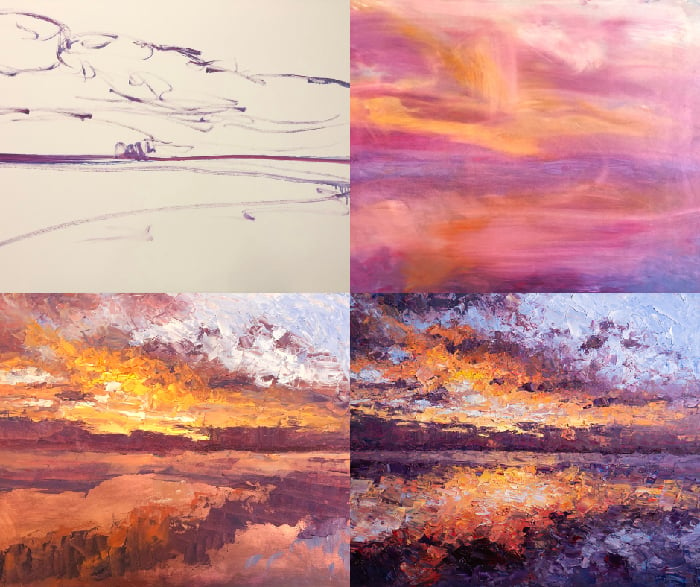
You Are the Best Person to Decide on the Optimal Strategy
Readers often send me reference photos asking how I would go about painting them and what strategy I would use. The problem is, any strategy I come up with is tailored to suit me, how I paint, and my vision of the finished painting. It’s not suited to other artists.
You are the best person to come up with the strategy for your painting. You won’t always pick right, especially if you’re starting out on your painting journey, but it’s better than letting some other artist pick for you.
Practical Example
I’ll run through a practical example to demonstrate what all this means. Below is a reference photo I plan on painting when I get a chance.

First, I try to visualize the finished painting. I see drama and warmth from the sunset. The jetty is dark and intricate. The water and open sky is shimmering. The clouds are ominous.
What do I want the painting to say?
I want to capture the unique character and nature of the jetty. I want to be able to look at the painting and recognize that this is the Kingfisher Bay jetty, not just any jetty. I also want the jetty to appear distinct, whilst also in harmony with the surrounding landscape. The painting must look united as one. Those brilliant warm colors in the sky and shimmering off the water’s surface will also be a key feature.
What’s the easiest way to do this?
I think a combined approach would work well here. For the lighter areas, I would use impressionist techniques such as broken color and multicolored strokes. I would also compress the value range to simplify the painting. For the jetty, I would be vague in my description, leaving things ambiguous in the shadows. But I would be accurate with the key details and things that characterize this jetty.
I would start by rapidly painting the sky and sea, leaving the jetty until last. The sky and sea could be done in a single session, and the jetty could be done on a separate session if necessary. Ideally, though, I would do it all in a single session.
I would use medium to large flat brushes for the sky and sea. I’d need a few round brushes and perhaps palette knives for the jetty.
That should do it in terms of strategy. I’ll let you know how the painting turns out!
Want to Learn More?
You might be interested in my Painting Academy course. We have rolled back the price for the next few days and added a heap of bonuses.
Thanks for Reading!
I appreciate you taking the time to read this post and I hope you found it helpful. Feel free to share it with friends.
Happy painting!
Dan Scott

Draw Paint Academy


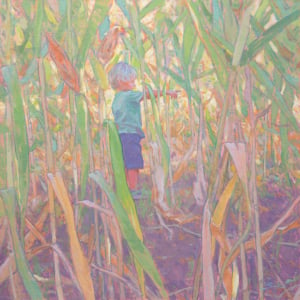
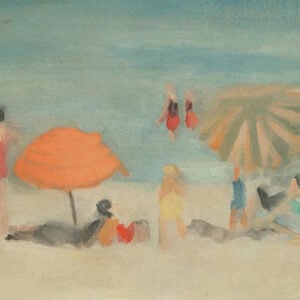

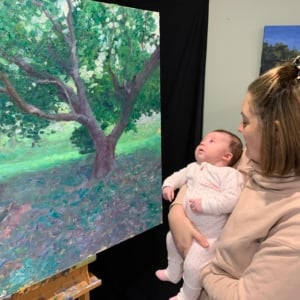
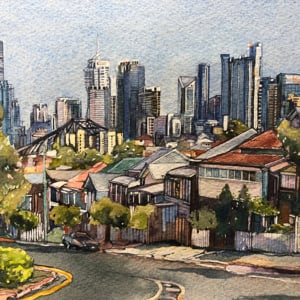
Are you going to give those a schedule. And how much does it cost
Thanks Dan! Great article.
Thanks Dan. I really like your work. I have to disagree though with your view that “vibrant colours can only be achieved with oils”. I’ve found that when using “Atelier Interactive” acrylic paint, it produces really incredibly vibrant colours (much more so than oils).
I found so much good advice and direction in this latest article, including your U Tube video of your magenta flowers painting. Thank you so much for the helpful instruction for beginning artist, as well as those who are a little further on their painting journey!
Wow your work is amazing and shows different styles. The painting, Magenta Flowers, has a distinct Monet look:-)
Wow! In your Perth, Cape Peron painting, the sun on the white part of the wave really glistens like the photo. It’s lovely!
Just read your article and enjoy your way of expressing your suggestions. Thank you for all the time you devote to helping people with creative talent venture into painting.’
Thanks Dan. Instructive and helpful, as always. I may have missed it, but you did not mention what medium you’ll be using. I presume oil? Looking forward to your feedback on this project.